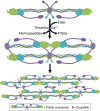Newly-Recognized Roles of Factor XIII in Thrombosis
- PMID: 27056150
- PMCID: PMC5680043
- DOI: 10.1055/s-0036-1571343
Newly-Recognized Roles of Factor XIII in Thrombosis
Abstract
Arterial and venous thromboses are major contributors to coagulation-associated morbidity and mortality. Greater understanding of mechanisms leading to thrombus formation and stability is expected to lead to improved treatment strategies. Factor XIII (FXIII) is a transglutaminase found in plasma and platelets. During thrombosis, activated FXIII cross-links fibrin and promotes thrombus stability. Recent studies have provided new information about FXIII activity during coagulation and its effects on clot composition and function. These findings reveal newly-recognized roles for FXIII in thrombosis. Herein, we review published literature on FXIII biology and effects on fibrin structure and stability, epidemiologic data associating FXIII with thrombosis, and evidence from animal models indicating FXIII has an essential role in determining thrombus stability, composition, and size.
Thieme Medical Publishers 333 Seventh Avenue, New York, NY 10001, USA.
Conflict of interest statement
The authors declare no competing financial interests.
Figures


References
-
- Wolberg AS, Rosendaal FR, Weitz JI, et al. Venous thrombosis. Nature Reviews Disease Primers. 2015;1:1–17. - PubMed
-
- Muszbek L, Bereczky Z, Bagoly Z, Komaromi I, Katona E. Factor XIII: a coagulation factor with multiple plasmatic and cellular functions. Physiol Rev. 2011;91(3):931–972. - PubMed
-
- Fickenscher K, Aab A, Stuber W. A photometric assay for blood coagulation factor XIII. Thromb Haemost. 1991;65(5):535–540. - PubMed
-
- Schroeder V, Kohler HP. Factor XIII, structure and function. Sem Thromb Haemost. 2016 In Press. - PubMed
Publication types
MeSH terms
Substances
Grants and funding
LinkOut - more resources
Full Text Sources
Other Literature Sources
Medical

